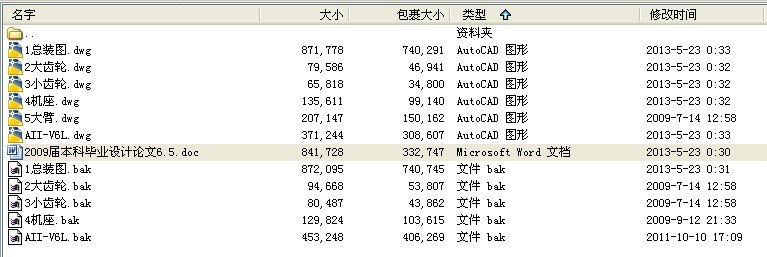 毕业设计-AⅡ-V6L焊接机器人结构设计
毕业设计-AⅡ-V6L焊接机器人结构设计
- 资源类别:论文
- 资源分类:机械机电
- 适用专业:机械设计制造及其自动化
- 适用年级:大学
- 上传用户:xuehi
- 文件格式:word+autoCAD
- 文件大小:2.68MB
- 上传时间:2013/12/9 3:04:52
- 下载次数:3 次
- 浏览次数:275 次
资料简介
毕业设计-AⅡ-V6L焊接机器人结构设计,共45页,20888字,附设计图纸。
摘 要
随着科技的发展和工业需求的增加,焊接技术在工业生产中所占据的分量越来越大,而且焊接技术的优良程度直接影响着零件或产品的质量。国内焊接机器人应用虽已具有一定规模,但与我国焊接生产总体需求相差甚远。因此,大力研究并推广焊接机器人技术势在必行。
本设计的重点是运用机械原理和机械制造装备设计方法设计焊接机器人的实践和方法。本次设计实践,是在了解焊接机器人在国内外现状的基础上,进而掌握焊接机器人内部结构和工作原理,并对机座和大臂进行结构设计。合理布置了电机和减速器。同时了解机器人机械系统运动学及运动控制学。为工业上焊接机器人的设计提供理论参考、设计参考和数据参考,为工业设计者提供设计理论和设计实践的参考。该机器人具有刚性好,位置精度高、运行平稳的特点。
关键字:焊接 机器人
Abstract
With the development of science and technology and industry increased the demand for welding technology in the industrial production by increasing the weight of occupation, and the fine degree of welding technology with a direct impact on the quality of parts or products. Although the domestic application of welding robot with a certain scale, but overall demand in China falls far short of welding production. Therefore, the strong research and technology is imperative to promote welding robot.
The focus of this design is the use of mechanical theory and design of machinery and equipment designed practice welding robot and methods. The design practice and understanding of welding robot in the status quo at home and abroad on the basis of the welding robot to grasp the internal structure and working principle of the arm base and the structural design. Rational arrangement of the motor and reducer. Mechanical systems at the same time understand the robot kinematics and motion control school. Welding robot for industrial design and provide a theoretical reference, reference and data reference design for industrial designers design theory and practice of the reference design. The robot has a rigid, and the location of high precision, smooth running characteristics.
Keywords: welding robot
摘 要 3
Abstract 4
1. 机器人概述 5
1.1焊接机器人的现状 5
1.1.1国外焊接机器人的现状 5
1.1.2国内焊接机器人的现状 6
1.2焊接机器人的发展趋势 7
1.2.1国外焊接机器人的发展趋势 7
1.2.2国内焊接机器人的发展趋势 7
1.3 我要研究什么 7
2. 机器人系统结构设计 8
2.1焊接机器人构成及工作原理 8
2.1.1 操作机 8
2.1.2 末端执行器 9
2.1.3 传感器系统 9
2.2 焊接机器人分类 10
2.3 AⅡ-V6L主要参数 11
2.4主要功能 12
2.5主要结构尺寸 13
2.6控制器 15
3. 动力选择 16
3.1 驱动方式 16
3.1.1 液压驱动 16
3.1.2 气动驱动 16
3.1.3 电动驱动 17
3.2 工业机器人驱动系统设计原则 17
3.2.1 控制方式 17
3.2.2 作业环境要求 18
3.2.3 操作运行速度 18
3.3 电机 18
3.4 电机的选择 19
4. 关节设计 20
4.1 大臂设计 20
4.2 机座和腰部设计 21
4.3谐波减速器 22
4.3.1 谐波减速器工作原理 22
4.3.2 谐波减速器的选择 22
4.4 圆柱齿轮传动 24
5. 机器人轴承设计 28
5.1 工业机器人专用轴承结构形式 28
5.2工业机器人专用轴承特点 29
5.2.1薄壁密封四点接触球轴承特点 29
5.2.2 薄壁密封交叉滚子轴承特点 29
5.3 薄壁四点接触琢轴承设计 29
5.3.1 主参数优化设计 29
5.3.2 约束条件 30
5.3.3 关键结构参数设计 30
6.机器人机械系统运动学及运动控制 32
6.1 运动学 32
6.1.1 机器人运动学方程 32
6.1.2 正向运动学 33
6.2 运动控制 36
6.2.1 工业机器人控制的特点 36
6.2.2工业机器人控制的分类 37
6.2.3位置控制问题 38
7.总结 40
致谢辞 41
参考文献 43
附: 44

摘 要
随着科技的发展和工业需求的增加,焊接技术在工业生产中所占据的分量越来越大,而且焊接技术的优良程度直接影响着零件或产品的质量。国内焊接机器人应用虽已具有一定规模,但与我国焊接生产总体需求相差甚远。因此,大力研究并推广焊接机器人技术势在必行。
本设计的重点是运用机械原理和机械制造装备设计方法设计焊接机器人的实践和方法。本次设计实践,是在了解焊接机器人在国内外现状的基础上,进而掌握焊接机器人内部结构和工作原理,并对机座和大臂进行结构设计。合理布置了电机和减速器。同时了解机器人机械系统运动学及运动控制学。为工业上焊接机器人的设计提供理论参考、设计参考和数据参考,为工业设计者提供设计理论和设计实践的参考。该机器人具有刚性好,位置精度高、运行平稳的特点。
关键字:焊接 机器人
Abstract
With the development of science and technology and industry increased the demand for welding technology in the industrial production by increasing the weight of occupation, and the fine degree of welding technology with a direct impact on the quality of parts or products. Although the domestic application of welding robot with a certain scale, but overall demand in China falls far short of welding production. Therefore, the strong research and technology is imperative to promote welding robot.
The focus of this design is the use of mechanical theory and design of machinery and equipment designed practice welding robot and methods. The design practice and understanding of welding robot in the status quo at home and abroad on the basis of the welding robot to grasp the internal structure and working principle of the arm base and the structural design. Rational arrangement of the motor and reducer. Mechanical systems at the same time understand the robot kinematics and motion control school. Welding robot for industrial design and provide a theoretical reference, reference and data reference design for industrial designers design theory and practice of the reference design. The robot has a rigid, and the location of high precision, smooth running characteristics.
Keywords: welding robot
摘 要 3
Abstract 4
1. 机器人概述 5
1.1焊接机器人的现状 5
1.1.1国外焊接机器人的现状 5
1.1.2国内焊接机器人的现状 6
1.2焊接机器人的发展趋势 7
1.2.1国外焊接机器人的发展趋势 7
1.2.2国内焊接机器人的发展趋势 7
1.3 我要研究什么 7
2. 机器人系统结构设计 8
2.1焊接机器人构成及工作原理 8
2.1.1 操作机 8
2.1.2 末端执行器 9
2.1.3 传感器系统 9
2.2 焊接机器人分类 10
2.3 AⅡ-V6L主要参数 11
2.4主要功能 12
2.5主要结构尺寸 13
2.6控制器 15
3. 动力选择 16
3.1 驱动方式 16
3.1.1 液压驱动 16
3.1.2 气动驱动 16
3.1.3 电动驱动 17
3.2 工业机器人驱动系统设计原则 17
3.2.1 控制方式 17
3.2.2 作业环境要求 18
3.2.3 操作运行速度 18
3.3 电机 18
3.4 电机的选择 19
4. 关节设计 20
4.1 大臂设计 20
4.2 机座和腰部设计 21
4.3谐波减速器 22
4.3.1 谐波减速器工作原理 22
4.3.2 谐波减速器的选择 22
4.4 圆柱齿轮传动 24
5. 机器人轴承设计 28
5.1 工业机器人专用轴承结构形式 28
5.2工业机器人专用轴承特点 29
5.2.1薄壁密封四点接触球轴承特点 29
5.2.2 薄壁密封交叉滚子轴承特点 29
5.3 薄壁四点接触琢轴承设计 29
5.3.1 主参数优化设计 29
5.3.2 约束条件 30
5.3.3 关键结构参数设计 30
6.机器人机械系统运动学及运动控制 32
6.1 运动学 32
6.1.1 机器人运动学方程 32
6.1.2 正向运动学 33
6.2 运动控制 36
6.2.1 工业机器人控制的特点 36
6.2.2工业机器人控制的分类 37
6.2.3位置控制问题 38
7.总结 40
致谢辞 41
参考文献 43
附: 44
资料预览图片:

资料文件预览
共2文件夹,12个文件,文件总大小:4.01MB,压缩后大小:2.68MB
- 毕业设计-AⅡ-V6L焊接机器人结构设计
- 工业机器人 论文+CAD图纸
 1总装图.bak [851.66KB]
1总装图.bak [851.66KB] 1总装图.dwg [851.35KB]
1总装图.dwg [851.35KB] 2009届本科毕业设计论文6.5.doc [822.00KB]
2009届本科毕业设计论文6.5.doc [822.00KB] 2大齿轮.bak [92.45KB]
2大齿轮.bak [92.45KB] 2大齿轮.dwg [77.72KB]
2大齿轮.dwg [77.72KB] 3小齿轮.bak [78.60KB]
3小齿轮.bak [78.60KB] 3小齿轮.dwg [64.28KB]
3小齿轮.dwg [64.28KB] 4机座.bak [126.78KB]
4机座.bak [126.78KB] 4机座.dwg [132.43KB]
4机座.dwg [132.43KB] 5大臂.dwg [202.29KB]
5大臂.dwg [202.29KB] AII-V6L.bak [442.63KB]
AII-V6L.bak [442.63KB] AII-V6L.dwg [362.54KB]
AII-V6L.dwg [362.54KB]
下载地址
- [ 毕业设计-AⅡ-V6L焊接机器人结构设计下载 ] (需要: 119 个学海币) 如何赚学海币
资料评论
注意事项
下载FAQ:
Q: 为什么我下载的文件打不开?
A: 本站所有资源如无特殊说明,解压密码都是www.xuehai.net,如果无法解压,请下载最新的WinRAR软件。
Q: 我的学海币不多了,如何获取学海币?
A: 上传优质资源可以获取学海币,详细见学海币规则。
Q: 为什么我下载不了,但学海币却被扣了?
A: 由于下载人数众多,下载服务器做了并发的限制。请稍后再试,48小时内多次下载不会重复扣学海币。
下载本文件意味着您已经同意遵守以下协议
1. 文件的所有权益归上传用户所有。
2. 未经权益所有人同意不得将文件中的内容挪作商业或盈利用途。
3. 学海网仅提供交流平台,并不能对任何下载内容负责。
4. 下载文件中如有侵权或不适当内容,请与我们联系,我们立即纠正。
5. 本站不保证提供的下载资源的准确性、安全性和完整性, 同时也不承担用户因使用这些下载资源对自己和他人造成任何形式的伤害或损失。
Q: 为什么我下载的文件打不开?
A: 本站所有资源如无特殊说明,解压密码都是www.xuehai.net,如果无法解压,请下载最新的WinRAR软件。
Q: 我的学海币不多了,如何获取学海币?
A: 上传优质资源可以获取学海币,详细见学海币规则。
Q: 为什么我下载不了,但学海币却被扣了?
A: 由于下载人数众多,下载服务器做了并发的限制。请稍后再试,48小时内多次下载不会重复扣学海币。
下载本文件意味着您已经同意遵守以下协议
1. 文件的所有权益归上传用户所有。
2. 未经权益所有人同意不得将文件中的内容挪作商业或盈利用途。
3. 学海网仅提供交流平台,并不能对任何下载内容负责。
4. 下载文件中如有侵权或不适当内容,请与我们联系,我们立即纠正。
5. 本站不保证提供的下载资源的准确性、安全性和完整性, 同时也不承担用户因使用这些下载资源对自己和他人造成任何形式的伤害或损失。
